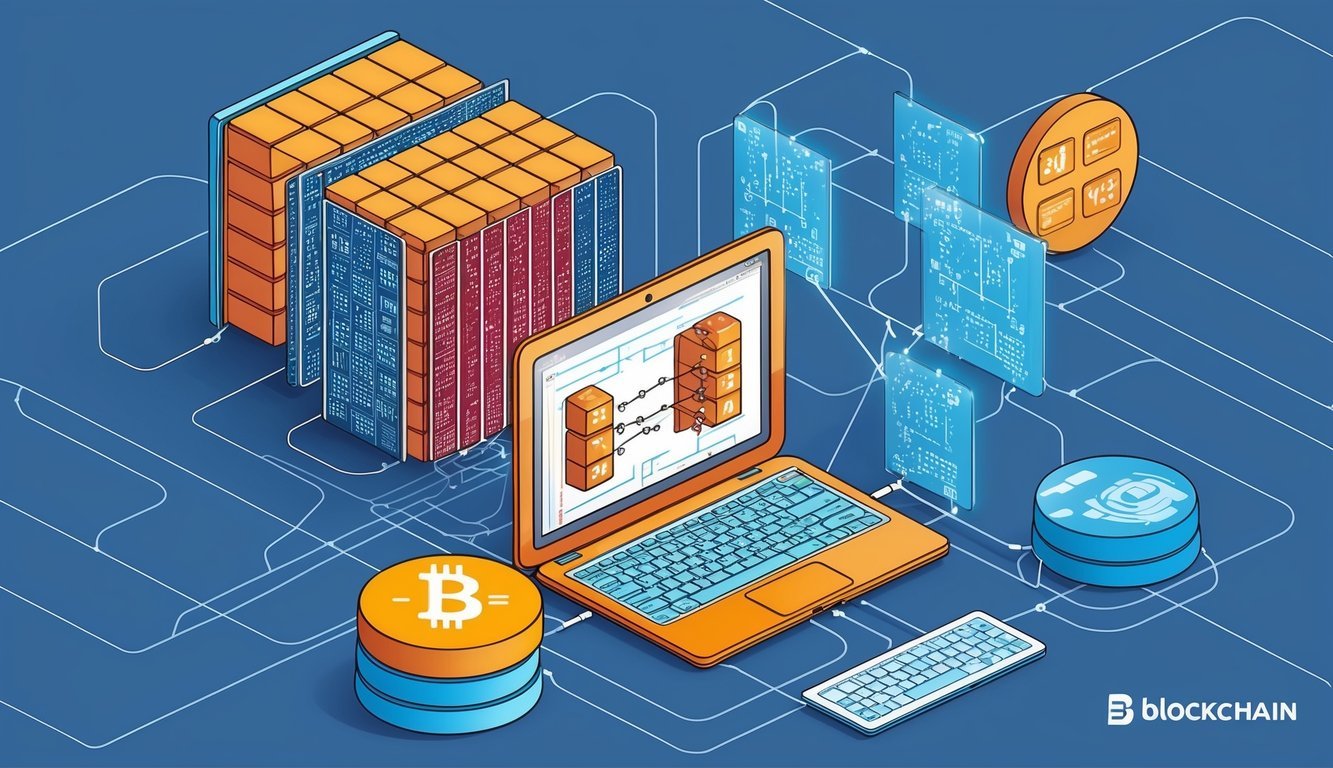Proof of Work (PoW) is a key part of many cryptocurrencies. It’s the system that keeps everything running smoothly and safely. PoW is a consensus mechanism that requires miners to solve complex math problems to add new blocks to the blockchain.

You might wonder why this matters. Well, PoW helps keep the network secure and stops bad actors from messing with transactions. It’s like a digital guard dog for your crypto. Bitcoin, the big dog in the crypto world, uses PoW.
But PoW isn’t perfect. It uses a lot of energy, which some people worry about. This has led to new ideas about how to keep crypto networks safe without using so much power.
Key Takeaways
- PoW keeps cryptocurrency networks secure by making miners solve tough math problems
- Bitcoin and many other popular cryptocurrencies use PoW to verify transactions
- PoW uses a lot of energy, which has led to the creation of alternative systems
Understanding Proof of Work
Proof of Work is a key concept in blockchain technology. It’s the system that keeps many cryptocurrencies secure and running smoothly. Let’s explore how it came to be, how it works, and why it matters for miners.
Historical Background of PoW
Proof of Work wasn’t born with Bitcoin. It has roots going back to the 1990s. Two computer scientists, Cynthia Dwork and Moni Naor, first came up with the idea in 1993. They wanted to fight spam emails and denial-of-service attacks.
Later, in 1997, Adam Back created Hashcash. This system used a similar idea to make it costly to send spam. It made computers do a bit of work before sending an email.
Fast forward to 2008. A mysterious figure called Satoshi Nakamoto took this concept and applied it to digital money. This led to the birth of Bitcoin and modern cryptocurrency mining.
How Proof of Work Functions
At its heart, Proof of Work is about solving puzzles. When you want to add new info to the blockchain, you need to do some work first. This work involves finding a special number called a nonce.
Here’s how it goes:
- You bundle up new transactions into a block.
- You guess a nonce and add it to the block.
- You run the block through a hashing algorithm.
- If the resulting hash meets the target, you win!
- If not, you try again with a new nonce.
It’s like a game of guess-the-number, but with really big numbers. The first to guess right gets to add their block to the chain.
The Role of Miners and Mining Rewards
Miners are the backbone of a Proof of Work system. They’re the ones doing all that guessing we talked about earlier. But why bother? Well, there’s a reward up for grabs.
Every time a miner solves the puzzle first, they get a prize. This usually comes in two parts:
- A set amount of new cryptocurrency
- Transaction fees from the transactions in their block
This reward system does two things. It encourages miners to keep the network running. It also slowly releases new coins into circulation. The more miners join in, the harder the puzzles get. This keeps block times steady and the network secure.
Challenges and Limitations of PoW
Proof of Work (PoW) faces some big hurdles. These issues affect how well it works and how people view it. Let’s look at the main problems with PoW.
Environmental Impact and Energy Usage
PoW is energy-intensive. It uses a lot of power to run the computers that solve puzzles. This high energy use is bad for the environment.
You might be surprised how much electricity PoW needs. It’s like powering a small country! This causes worry about climate change.
Some folks try to use clean energy for mining. But it’s still a big drain on resources. The push for green mining helps, but doesn’t solve everything.
As more people use cryptocurrencies, the energy problem gets bigger. It’s a tough balance between security and being eco-friendly.
Security Concerns and the 51% Attack
PoW aims to keep your transactions safe. But it’s not perfect. One big risk is the 51% attack.
In a 51% attack, bad guys take over most of the network’s power. This lets them cheat the system. They can spend coins twice or block other people’s transactions.
While it’s hard to do, it’s not impossible. Smaller networks are more at risk. Big networks like Bitcoin are safer, but not immune.
PoW also fights other tricks like denial-of-service attacks. But as tech grows, new threats pop up too.
Scalability and Performance Issues
PoW has trouble growing big. It’s slow compared to regular payment systems. This makes it hard for everyday use.
You might wait a while for your transaction to go through. The network can only handle so many at once. This causes delays and higher fees when it’s busy.
As more people use the network, these problems get worse. It’s tough to keep things fast and cheap as it grows.
Some solutions try to fix this. But they often trade off security or being decentralized. Finding the right balance is tricky.
PoW’s limits on speed and size are big challenges. They need fixing for wider use of blockchain tech.
Proof of Work vs. Other Consensus Mechanisms
Blockchain networks use different ways to agree on transactions. Let’s look at how Proof of Work compares to other methods and what might come next.
Comparison with Proof of Stake (PoS)
Proof of Stake (PoS) is a popular alternative to Proof of Work. In PoS, you don’t need powerful computers to mine. Instead, you “stake” your coins as collateral.
PoS uses way less energy than PoW. This is good for the planet. It’s also cheaper to run, which can mean lower fees for you.
Networks like Ethereum, Cardano, and Cosmos use PoS. They say it’s faster and can handle more transactions.
But PoS has its downsides. Some worry it might favor the rich who can stake more. PoW fans say it’s not as secure as their method.
Hybrid Models and Future Directions
Some networks are trying to mix PoW and PoS. They want the best of both worlds.
These hybrid models aim to be secure like PoW but efficient like PoS. They might be the future of blockchain.
New ideas are popping up too. Some focus on being green. Others try to make transactions super fast.
As tech grows, you might see even cooler ways to keep blockchains safe and quick. The goal is to make digital money work better for everyone.
Frequently Asked Questions

Proof of Work is a complex topic with many aspects to explore. Let’s dive into some common questions about this blockchain consensus mechanism.
Why does Bitcoin use Proof of Work instead of other consensus methods?
Bitcoin uses Proof of Work because it’s secure and decentralized. It makes it hard for anyone to take control of the network.
PoW also helps prevent double-spending. This keeps the Bitcoin system fair and trustworthy.
What’s the main difference between Proof of Work and Proof of Stake?
The main difference is how they validate transactions. Proof of Work uses computing power, while Proof of Stake uses coin ownership.
In PoW, miners solve puzzles. In PoS, validators stake their coins. PoS uses less energy than PoW.
Can you give an example of how Proof of Work functions in practice?
In Bitcoin, miners compete to solve a math problem. The first to solve it gets to add a new block to the chain.
This process happens about every 10 minutes. The winner gets new bitcoins as a reward.
What makes Proof of Work secure and how does it prevent fraud?
PoW is secure because it’s costly and time-consuming. Attackers would need massive computing power to cheat the system.
It prevents fraud by making it very expensive to alter past transactions. The longer the chain, the harder it is to change.
How does Proof of Work impact the energy consumption of a blockchain system?
PoW uses a lot of energy. Miners need powerful computers running 24/7 to solve puzzles.
This high energy use is a big criticism of PoW. It’s why some blockchains are switching to other methods.
How does Proof of Stake differ from Proof of Work in terms of blockchain validation?
In Proof of Stake, you don’t need powerful computers. Instead, you “stake” your coins to become a validator.
The more coins you stake, the more likely you are to be chosen to validate transactions. This uses much less energy than PoW.





